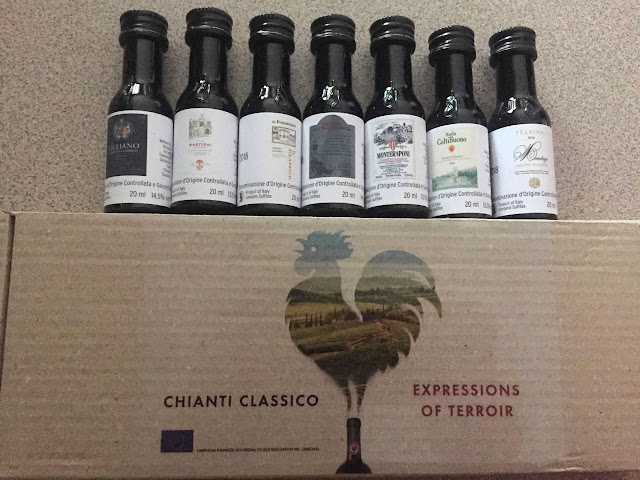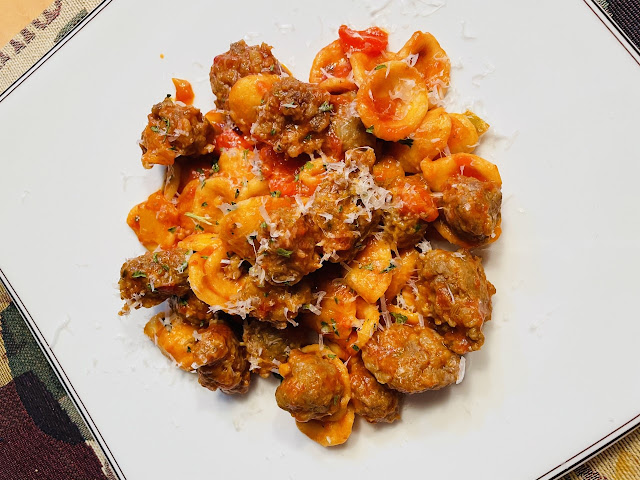I attended a virtual horizontal tasting last month called “Expressions of Terroir” sampling the different communes of Chianti Classico led by Jeff Porter in partnership with the Chianti Classico Consortium. The tasting was focused on learning and understanding the difference between the communes and the styles they produce. Each have a variety of different soils, altitudes, climates etc. each playing their own role in the development of the grapes.
Chianti Classico is the oldest appellation in Italy. The land had been
defined in 1716 by Cosimo del Medici, but the specific Classico territory wasn’t established until 1932. What we know as the “recipe”
for Chianti Classico was created by Bettino Ricasoli in 1848, which originally
included white grapes that have been removed as of 2006.
The territory contains 10,000 hectares under vine with 7,200
hectares dedicated to Chianti Classico over 515 estates. Forty percent of these producers are either
certified or under conversion to be certified while 70% of them are practicing
sustainability. Even one third of them are
using alternative sources for energy so there is a strong focus in this appellation for the preservation of the environment and it’s resources.
There are 4 different soils that primarily make up the vineyards
of Chianti Classico including alberese, lending acidity, galestro producing
wines with sapidity, macigno Toscano, a sandy and light well drained soil and
lastly argille, a clay based soil good for moisture retention.
The Wines
Now a focus on the Chianti Classico wines tasted. There were a taste of seven samples from the northern part of
the territory in the Florence province to the southern part of Chianti Classico
in the Siena province. Although I
enjoyed them all, four of them were my particular favorites.
San Cassiano in Val di Pesa (Florence) – Fattoria I Collazzi
This is the closest commune to the city of Florence just
southwest on the outskirts. San Casciano
in Val di Pesa is a lower altitude and one of the warmer communes. It’s a smaller territory with Fattoria I
Collazzi occupying 400 hectares with 200 hectares planted to olive trees and only 10 hectares dedicated to Chianti
Classico vineyards at about 1,000 feet above sea level.
San Casciano is located along two ancient rivers, Greve and
Pesa, that are west and east of town.
The soils are alluvial consisting mostly of clay and galestro along with
some river pebbles that allow the wines some softness and approachability. The galestro helps with the acidity in the
wine and provides structure, but elegance.
The 2018 I Collazzi I Bastioni Chianti Classico DOCG
is made of 80% Sangiovese with 18% Merlot and 2% Malvasia Nera. It’s aged 12 months in barrel with an
additional 4 months in the bottle. It’s a medium bodied wine with tart cherry and a vibrant acidity with cedar
and tobacco notes on the finish. Alberto
Torelli mentioned that the 2018 vintage was one of the best in the last 10
years with a balanced climate. ABV 13.5%
Greve in Chianti (Florence) –
Podere Castellinuzza
Greve in Chianti is located
southeast of Florence. It’s a quick jaunt outside of Florence and is a
quaint town with a great town center.
Podere Castellinuzza is located in the village of Lamole, only comprised of 9 producers
total in the Monte del Chianti so the vineyards are at high altitudes. The area is known for their irises, olives
and vines with an aquaphor underneath the village providing water to the
area. Podere Castellinuzza has about 3.5 hectares of
vines.
The soil in the area is made
primarily of macigno del chianti, a sandstone that faces a lot of water stress
and results in wines that are more floral, elegant and with the higher altitudes
you’ll see wines with higher acidity.
The 2018 Podere Castellinuzza
Chianti Classico DOCG is made of 95% Sangiovese and 5% Canaiolo. It’s aged 18 months in barrel with 6 months
in the bottle. A sweeter nose of ripe cherries. It’s vibrant, floral and fresh being more
fruit forward than the others. ABV 14%
Barberino Tavarnelle (Florence) – Il Poggiolino
Barberino Tavarnelle is on the northwestern side of the
appellation, therefore receiving some of the winds from the Mediterranean
Sea. The winters are milder with the
summers cooler and breezy so the vines sprout earlier with a later
harvest. The soil here is mostly made of
galestro with some flysch sediment and blue clay that maintains humidity and
balance for the summer months.
The 2018 Il Poggiolino Chianti Classico was a favorite
for me. Made of 95% Sangiovese with 5%
Colorino this wine is aged 8 months partially in both big and small barrel with
an additional 4 months in the bottle. A
balanced wine with nice structure and moderate tannin. Deeper cherry flavors with a licorice, herbal
notes and tobacco. Higher acidity with
nice length. ABV 13.5% SRP $25
 |
| Copyright of Consorzio Vino Chianti Classico |
Castellina in Chianti (Siena) – Tenuta di Lilliano
Castellina in Chianti is located northwest of Siena in the
southern part of Chianti Classico. It’s
a bigger subzone that is hard to define.
It is a warmer climate and Alessandro Ruspoli from Tenuta di Lilliano
defined the commune of Castellina in Chianti’s wines as “savory, balanced with
freshness”. The winery was started by
Alessandro’s grandmother in 1920 and was commercially bottled in 1958.
They own about 1,100 acres with 100 planted to vineyards and
the rest occupied by crops, olives and forest.
The soils are rich in alberese that result in wines that are fresh with
good acidity.
The 2018 Tenuta di Lilliano Chianti Classico DOCG was
another chosen favorite. Made of 90%
Sangiovese, 5% Colorino and 5% Merlot.
It was showing deeper, riper fruit of cherries and violet. Acidity was prevalent on the back tongues
with low to moderate tannin on the finish.
This wine was aged 12-14 months in botti with an additional 3 months in
the bottle. Momentarily the winery is
using 5% Merlot as the Canaiolo is being regrafted, but they plan to go back to
a heavier amount of Canaiolo to replace the Merlot. ABV 14.5%
Radda in Chianti (Siena) – Monteraponi
This is the smallest area of Chianti Classico just about 20km
north of Siena. A large part of this
territory is forest. Monteraponi has
been farming organically since 2009.
Their soil is primarily based on alberese lending acidity to the
wines. This is one of the oldest soils
in Chianti Classico. They have 12
hectares mostly planted to Sangiovese with some Canaiolo, Colorino and Trebbiano.
The 2018 Monteraponi Chianti Classico DOCG is made of
95% Sangiovese with 5% Canaiolo. It spent
16 months in French and Slavonian oak with an additional 2 months in the
bottle. This wine had juicy acidity showing more black cherry and a hint of menthol with
moderate tannin and a silky finish. When
I went back to retaste the wine after I even picked up a little toasted
marshmallow. ABV 13.5% SRP $28
Gaiole in Chianti (Siena) – Badia a Coltibuono
Gaiole in Chianti is northeast of Siena and there are about
45 producers there. It overlooks three
valleys and receives a lot of water from the mountains. It’s a larger territory and Roberto Stucchi Prinetti
of Badia a Coltibuono recommends that the territory be divided into 4 sub zones
since it’s very diverse between altitudes and soils. The soil contains a lot of limestone and in
northern Gaiole there is a lot of macigno that is lighter and sandier.
Monks had been making wine on their property since the 11th
century. The abbey is located in the
north of Gaiole, but the vineyards of Badia a Coltibuono are located in the
southern part of Gaiole and Roberto describes these typically as “concentrated,
robust and elegant”.
The 2018 Badia a Coltibuono Chianti Classico DOCG is
made of 90% Sangiovese with 10% native red grapes including Canaiolo, Colorino
and Ciliegiolo. It spends 12 months in
large botti with an additional 2 months in bottle. I’ve always been a fan of Badia a Coltibuono
so this was another favorite pick of mine. Well-balanced showing beautiful cherry notes, fresh acidity, and supple tannins. ABV 13.5% SRP $21
Castelnuovo Berardenga (Siena) – Felsina
Castelnuovo is the most southern part of Chianti Classico. It is more hilly than some of the other
communes and receives a light breeze and is an open area so it has nice
ventilation. They own a number of
vineyard sites over 72 hectacres so there are a variety of altitudes and
soils. Most of it is white alberese and
the sandy soils and limestone lend more florals to the wine.
The 2018 Felsina Berardenga Chianti Classico DOCG is
made of 100% Sangiovese selected from 11 of their parcels. It’s aged 12 months in barrel with an
additional 10 months in the bottle. This
is their mostly sold wine with a production of 280,000 bottles. This is their estate wine with the first vintage released in
1967. Chiara Leonini from the winery
says the main characteristics of their wine show herbal and balsamic notes. The wine is fresh with bright acidity, cherry, herbal and tobacco notes. A well-balanced wine. Another fav of the day! ABV 13.5% SRP $26
*These wines were provided as samples, but opinions are always my own.




